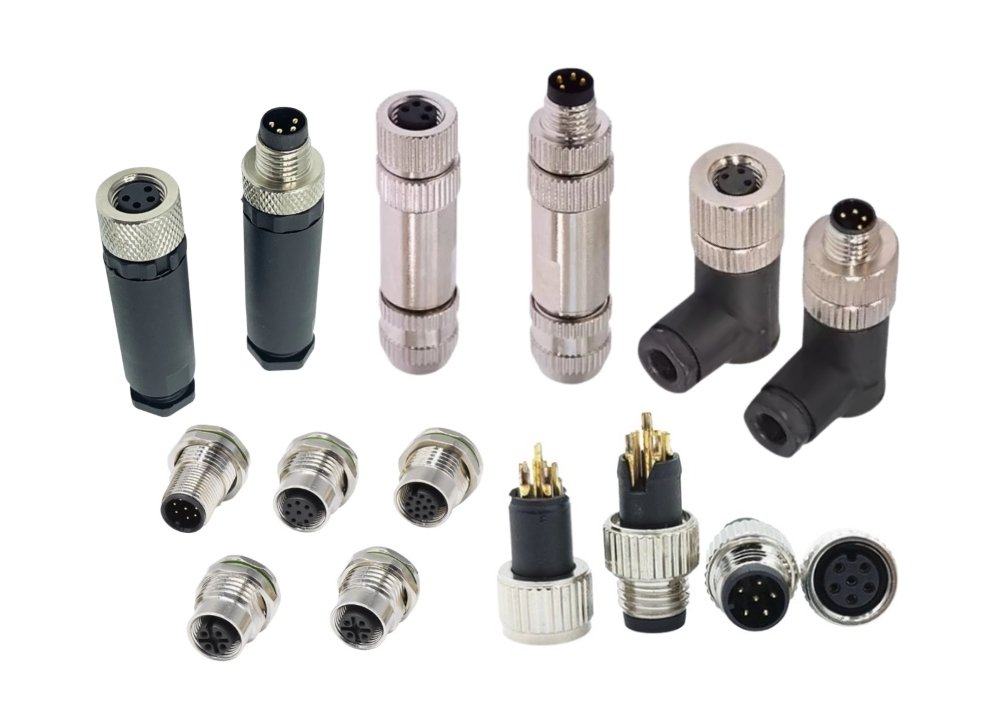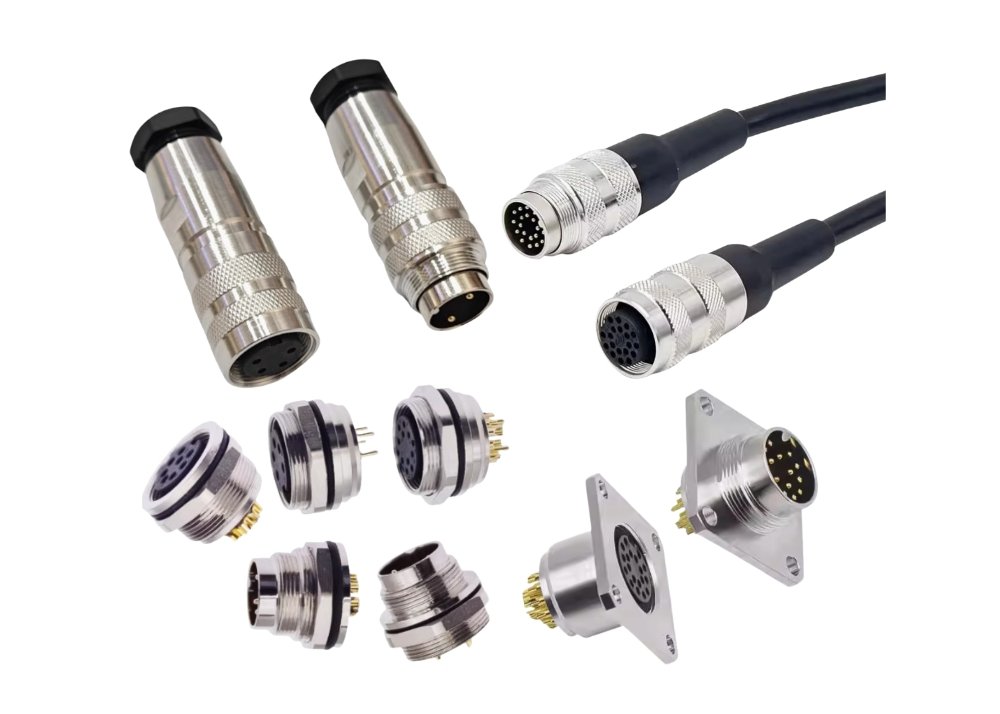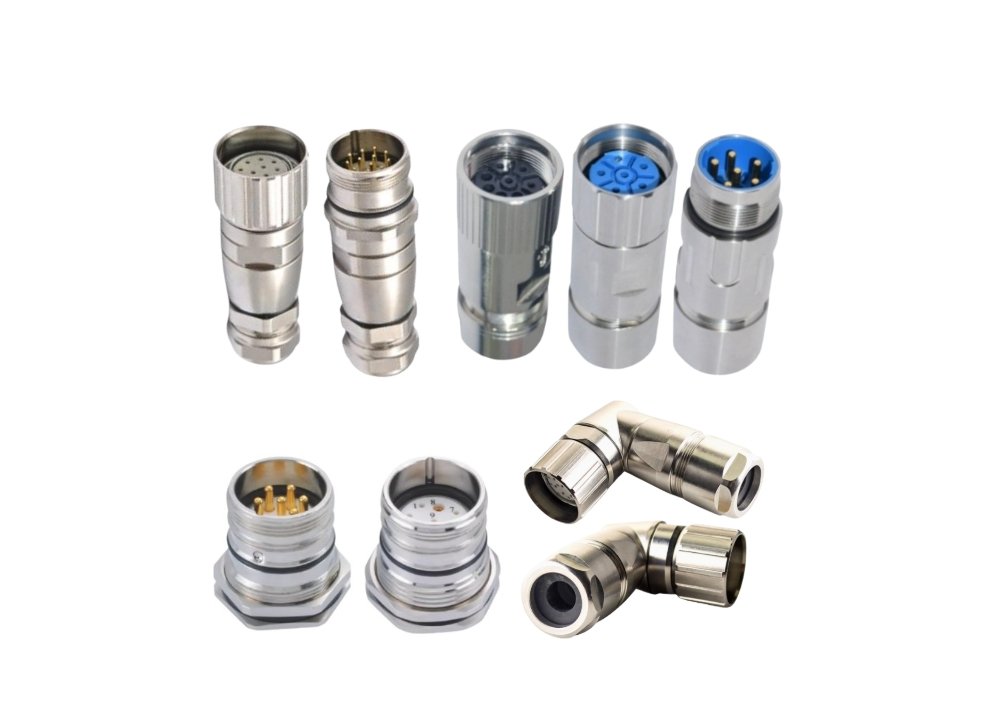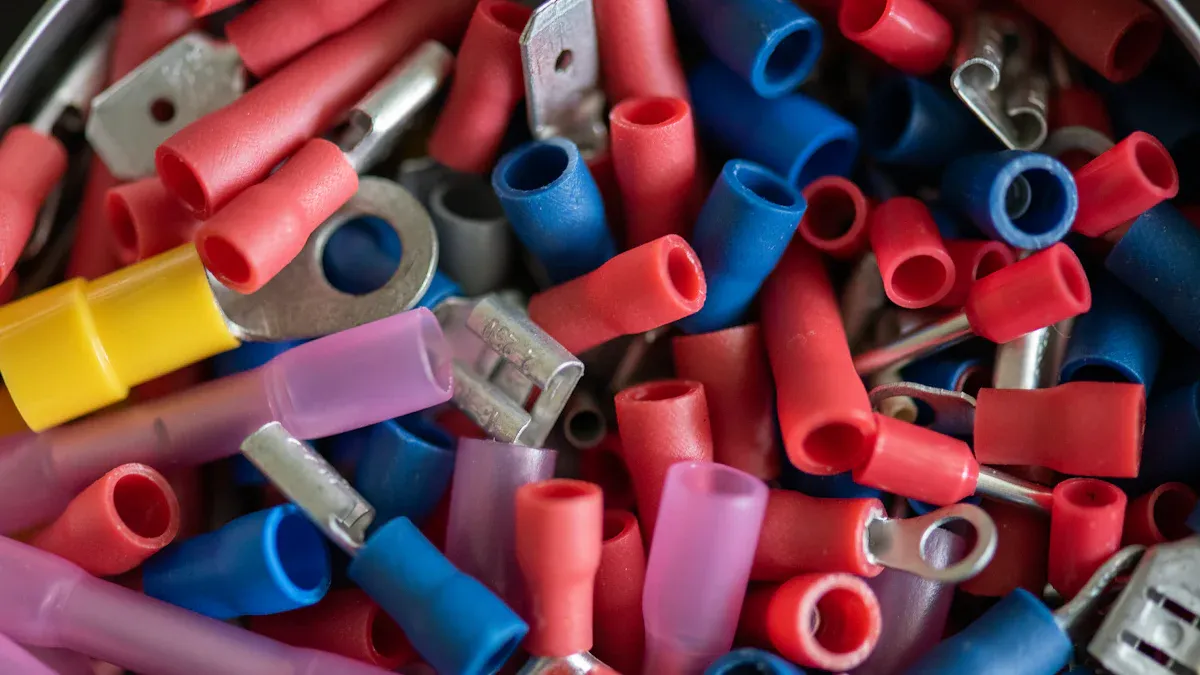
You face critical choices when selecting plastic connectors for your applications. Solutions from a Connector factory must deliver cost savings, lightweight construction, and robust durability. Solutions in automotive, telecommunications, and industrial automation highlight why plastic connectors excel over metal alternatives. Solutions such as the M8 connector or Type B connector offer improved performance through advanced materials, meeting harsh conditions and modern standards. Solutions tailored for Plastic Industrial Connectors ensure your connectors align with your specific needs.
Identifying Application Requirements for Plastic Industrial Connectors
Selecting the right plastic industrial connectors starts with a clear understanding of your application’s requirements. You must evaluate environmental conditions, mechanical load and stress, and electrical or data needs. Each factor directly impacts the performance and longevity of your connections in industrial and manufacturing processes.
Environmental Conditions
Temperature Range
You need to assess the temperature extremes your plastic connectors will face. Ambient temperature can significantly affect insulation performance. When temperatures rise above 50°C, changes in insulation properties become more pronounced. Prolonged exposure to heat and sunlight may cause deterioration, even in connectors with UV stability. Always check the minimum and maximum temperature tolerances, which typically range from -40° to 200°F for most plastic industrial connectors.
Tip: Regularly monitor the operating environment to ensure your connectors remain within their rated temperature range. This practice helps maintain system reliability.
Exposure to Moisture or Chemicals
Plastic connectors often outperform metal alternatives in moisture resistance. They resist saltwater and many chemicals better, making them ideal for harsh or corrosive environments. However, you should still consider the specific chemicals present in your setting. Humidity, rain, or splashing water can all impact the lifespan of your connections. UV stability is another critical factor, especially for outdoor installations.
- Better moisture resistance than metal connectors
- More resistant to saltwater
- UV stability, but prolonged exposure to heat and sunlight can cause deterioration
Environmental conditions such as humidity, temperature extremes, corrosive fluids, and vibration significantly affect the lifespan and performance of plastic industrial connectors. You must select connectors designed to endure these stressors to maintain reliability and durability.
Mechanical Load and Stress
Vibration and Impact Resistance
Industrial environments often expose connections to high vibration and impact. You should choose plastic connectors with high toughness, ductility, and impact strength. These properties ensure that your connections withstand repeated mechanical stress without failure. Compared to metal connectors, plastic connectors offer high flexibility and good wear resistance, making them suitable for frequent use.
| Feature | Plastic Connectors | Metal Connectors |
|---|---|---|
| Flexibility | High flexibility, suitable for various applications | Less flexible, more rigid |
| Weight | Lightweight, easier to handle | Heavier, can be cumbersome |
| Durability | Good wear resistance, suitable for frequent use | Highly durable, performs well under extreme conditions |
| Cost | Generally lower cost | Higher cost due to material and manufacturing |
| Industry Standards | Meets stringent standards in harsh environments | Established standards, reliable in industrial settings |
Weight Constraints
Weight plays a crucial role in system design. Plastic industrial connectors are lightweight, which reduces the overall load on your equipment. This benefit makes installation and maintenance easier, especially in applications where portability matters. Lightweight connections also minimize stress on mounting points and cables, extending the service life of your system.
Electrical and Data Needs
Non-Conductive Requirements
Plastic connectors provide excellent insulation properties. You should use them in applications where non-conductive materials are essential for safety. These connectors prevent accidental short circuits and protect sensitive electronic components. Always verify the current rating and rated voltage to ensure safe operation.
Signal Integrity and Shielding
Maintaining signal integrity is vital in industrial environments. Plastic industrial connectors often include design features that reduce electromagnetic interference (EMI). Shielding and impedance matching help prevent data loss and signal distortion. High-speed copper channels and proper conductor spacing further enhance performance in demanding applications.
- Shielding and impedance matching are critical for reducing EMI.
- The design of connectors helps mitigate reflections that can distort signals.
- High-speed copper channels maintain consistent impedance, essential for signal integrity.
- Insulation type and conductor spacing significantly influence performance in high-speed applications.
You must ensure that your connections meet the data transmission requirements for frequency and volume. Robust sealing and proper material selection help maintain reliable connections, even in harsh conditions.
Regulatory and Safety Standards
Industry Certifications
You must verify that your plastic connectors meet recognized industry certifications before deploying them in industrial environments. Certifications confirm that connectors comply with strict safety, performance, and environmental standards. This compliance increases reliability and expands the range of suitable applications. When you select certified connectors, you reduce the risk of system failures and ensure consistent operation under demanding conditions.
Note: Certified connectors often undergo rigorous testing for electrical insulation, mechanical strength, and resistance to environmental factors. You gain peace of mind knowing your components meet established benchmarks.
Compliance with Local Regulations
You need to ensure that your connectors adhere to local regulations in every region where your systems operate. Regulatory bodies set specific standards for connector design, material composition, and safety features. Failure to comply can result in legal penalties, project delays, or compromised safety.
The following table outlines key standards for plastic connectors across major regions:
| Region | Standards |
|---|---|
| U.S. | UL 486A-486B, UL 486C, UL 486D, UL 486E, UL 486F, UL 486G |
| Canada | CSA C22.2 No. 65, CSA C22.2 No. 188, CSA C22.2 No. 198.2, CSA C22.2 No. 291, CSA C22.2 No. 355 |
| Mexico | NMX-J-543-ANCE, NMX-J-548-ANCE, NMX-J-519-ANCE, NMX-J-745-ANCE-2018 |
| EU | IEC 61984:2008 |
| China | IEC 61984:2008 |
| Brazil | IEC 61984:2008 |
| India | IEC 61984:2008 |
You should review these standards before finalizing your connector selection. Each region enforces unique requirements, so you must match your connector’s certifications to the intended market. This step ensures legal compliance and protects your investment.
⚠️ Always consult with regulatory experts if you plan to deploy connectors in multiple countries. Regulations may change, and staying informed helps you avoid costly mistakes.
Comparing Plastic Connectors and Metal Connectors
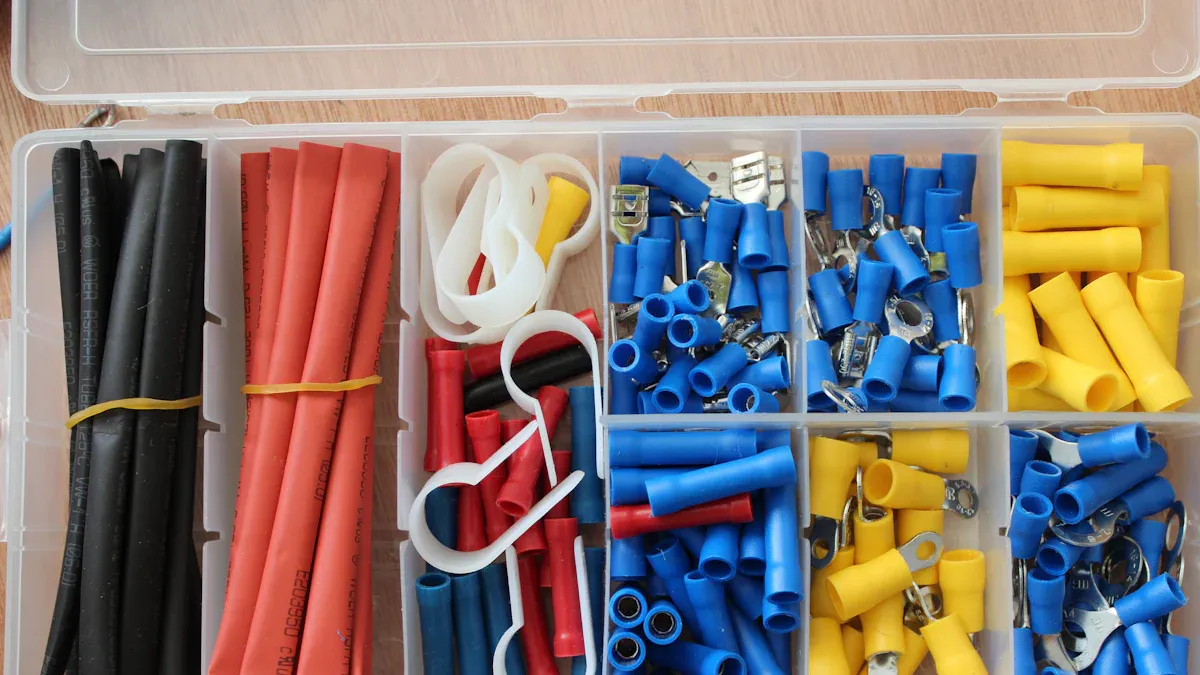
Cost-Effectiveness of Plastic Connectors
Initial Investment
You often seek cost-effectiveness when selecting connectors for industrial applications. Plastic connectors deliver significant savings compared to metal alternatives. The initial investment for plastic connectors remains lower, making them attractive for projects with tight budgets or high-volume requirements. The structure of thermoplastic quick connects is more reasonable, which further reduces manufacturing expenses.
| Connector Type | Cost Per Connector |
|---|---|
| Plastic | Lower cost |
| Metal | Higher cost |
Plastic connectors are generally more cost-effective with lower upfront costs. Metal connectors require a higher initial investment but offer longer lifespans and durability. You benefit from lightweight and affordable designs that help you manage costs without sacrificing essential performance.
Long-Term Maintenance
You must consider long-term maintenance when evaluating connector options. Thermoplastic quick connects provide lower maintenance costs due to their corrosion resistance and durability. These connectors resist moisture and chemicals, which reduces the need for frequent replacements. Metal connectors, while very durable, can rust in humid or marine environments and often require more attention over time.
| Connector Type | Advantages | Disadvantages |
|---|---|---|
| Plastic Connectors | Lower long-term maintenance costs due to durability and corrosion resistance. Lightweight and excellent chemical resistance. | Not suitable for all industrial uses; can break faster than metal; may deteriorate under high temperatures or sunlight. |
| Metal Connectors | Very durable; can handle high temperatures; suitable for food-grade environments. | Heavier; higher initial cost; prone to rust in humid or marine environments. |
Thermoplastic quick connects offer you savings in both initial investment and ongoing maintenance, especially in environments where corrosion is a concern.
Weight and Portability Advantages
Lightweight Benefits
You gain a clear advantage with lightweight thermoplastic quick connects. These connectors are flexible and easy to mold into custom shapes, which supports compact designs. You find this especially beneficial in consumer electronics and automotive wiring, where space and weight matter. Lightweight quick connects simplify installation and handling, making your workflow more efficient.
- Plastic connectors are lightweight and flexible, which facilitates easy molding into custom shapes.
- This flexibility enables compact designs, particularly beneficial for consumer electronics like smartphone ports and automotive wiring.
Impact on System Design
Switching from metal to thermoplastic quick connects can reduce connector housing weight by up to 50%. You experience easier assembly and quick mounting, which streamlines your production process. Modularisation and miniaturization allow you to add more functions in a smaller space, enhancing design flexibility. In railway vehicles, reducing connector weight improves energy efficiency and lowers overall system mass.
- The transition from metal to plastic can reduce connector housing weight by up to 50%.
- Plastic housings are lightweight and allow for quick mounting, facilitating easier assembly.
- Modularisation and miniaturization of connectors enable more functions in a smaller space, enhancing design flexibility.
Electrical Conductivity and Insulation
Insulation Properties of Plastic Connectors
You rely on thermoplastic quick connects for their superior insulation properties. These connectors excel in low temperature and lower pressure scenarios, making them ideal for sensitive electronic applications. Plastic connectors are lightweight and resistant to corrosion, which adds another layer of protection for your systems.
- Metal quick connect fittings excel in high temperature and high-pressure applications.
- Plastic quick connect fittings are effective for low temperature and lower pressure scenarios.
- Plastic connectors are generally more lightweight and resistant to corrosion.
Safety Considerations
Thermoplastic quick connects provide safety benefits in high-voltage or sensitive electronic applications. Connector caps shield electrical elements from dust, moisture, and corrosive substances, preventing degradation. You avoid electrical short-circuits by eliminating unintended contact between live wires or metal surfaces. Industry regulations often require the use of connector caps, ensuring compliance and protecting your investment.
- Connector caps protect sensitive electrical elements against dust, moisture, and corrosive substances, which can degrade wiring over time.
- They help prevent electrical short-circuits by eliminating unintended contact between live wires or metal surfaces.
- The use of connector caps is often required by industry regulations, ensuring compliance with safety standards.
Thermoplastic quick connects offer you reliable insulation and safety, making them a preferred choice for many industrial applications.
Durability and Longevity
Corrosion Resistance
You need connectors that withstand harsh environments without losing performance. Plastic connectors offer inherent corrosion resistance, which makes them suitable for many industrial applications. Unlike metal connectors, plastics do not require extra coatings to prevent rust or degradation. The use of high-performance polymers such as PEEK and PTFE ensures excellent chemical resistance and mechanical strength. Rubber and silicone components add flexibility and improve sealing, which helps block moisture and contaminants.
The following table compares material properties for corrosion resistance:
| Material Type | Properties | Application |
|---|---|---|
| High-temperature resistant plastic composites | Lightweight, flexible | Suitable for environments with extreme temperatures and moisture |
| Corrosion-resistant metal housing | Strong, durable | Ideal for harsh environments requiring robust connectors |
You benefit from thermoplastic housings that remain durable and cost-effective. These materials resist corrosion naturally, so you avoid frequent replacements and maintenance. In environments with aggressive chemicals or high humidity, plastic connectors maintain their integrity and performance.
Tip: Select connectors made from advanced polymers for maximum corrosion resistance in demanding settings.
Wear and Tear Over Time
You must consider how connectors perform over years of use. In industrial environments, connectors face constant stress from vibration, pressure, and temperature changes. Plastic connectors play a critical role in electronics, especially where durability matters. While metallic push connect fittings generally last longer than plastic options, you can extend the lifespan of plastic connectors by choosing the right materials and designs.
Factors such as exposure to chemicals, dynamic stresses, and extreme temperatures affect the longevity of both metal and plastic connectors. You should look for durable thermoplastic housings that resist cracking and deformation. High-performance polymers provide better wear resistance, so your connectors stay reliable even after repeated cycles.
- High-performance polymers like PEEK and PTFE offer excellent chemical resistance and mechanical properties.
- Rubber and silicone provide flexibility and sealing capabilities, ensuring effective ingress protection.
- The design of connectors for harsh environments often involves using durable thermoplastic housings, which are lighter and more cost-effective than metal options.
You gain long-term value by selecting connectors that match your application’s demands. Durable plastic connectors reduce downtime and replacement costs, helping you maintain efficient operations.
Evaluating Key Features of Plastic Industrial Connectors
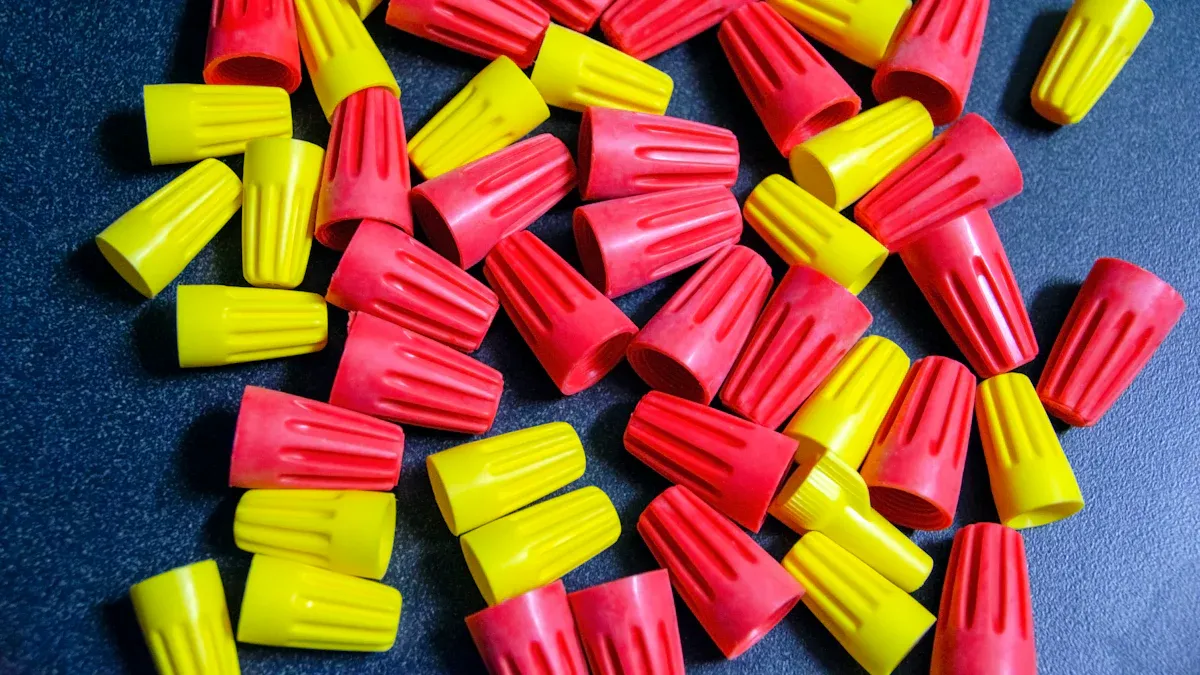
Sealing and Protection
IP Ratings Explained
You must understand IP ratings when selecting plastic connectors for demanding environments. IP ratings, defined by IEC standard 60529, indicate how well enclosures protect against dust and liquid intrusion. The first digit shows protection against solid objects, ranging from 0 (no protection) to 6 (complete dust protection). The second digit rates liquid intrusion, from 0 to 8. Higher IP ratings, such as IP67 or IP68, are essential for outdoor or wet applications. These ratings help you prevent water and debris from entering connectors, which can cause equipment damage.
Tip: Always check the IP rating before installation. Incorrectly specified connectors may lead to costly failures.
Dust and Water Resistance
You need reliable dust and water resistance to ensure safe operation. Waterproof connectors prevent water ingress, reducing risks of short circuits and corrosion. They also protect internal components from moisture, prolonging equipment lifespan. When choosing fittings, consider the materials used for O-rings and gaskets. These must withstand harsh conditions. Many connectors only seal when mated, so you should evaluate how well they protect interfaces when disconnected. Lightweight materials are preferred in transportation, as they help reduce fuel costs.
- Materials for sealing must resist chemicals and moisture.
- Design features that enhance IP ratings are crucial for protection.
- Sealing performance when unmated is often overlooked but vital.
Modularity and Flexibility in Lightweight Rectangular Plastic Connectors
Interchangeable Components
You benefit from modularity in lightweight rectangular plastic connectors. Modular designs, such as the Han 1A, allow you to configure systems with a small number of elements for various applications. You can choose between screw and crimp connection technologies, adapting to your needs. Accessories provide quick transformation to IP65 solutions, enhancing flexibility. Tool-less installation supports easy retrofitting, making upgrades simple.
| Feature | Description |
|---|---|
| Modular Design | Maximum flexibility with few elements for diverse applications. |
| Connection Options | Screw and crimp technologies available. |
| Accessories | Quick transformation to IP65 solutions. |
| Tool-less Installation | Fast retrofitting for future needs. |
Expansion Capabilities
You can expand your system easily with high-density modules. These fittings achieve increased functionality in limited space, supporting diverse applications. Customization is straightforward, often available through online configurators. The modular concept lets you create custom solutions for unique requirements. Space-efficient components maintain robustness while supporting miniaturization.
| Feature | Description |
|---|---|
| High-density Modules | Increased functionality in limited space. |
| Customization | Quick options for unique needs. |
| Versatility | Supports diverse applications with modular concepts. |
Connection Types and Mechanisms
Snap-In vs. Screw-In
You encounter several connection mechanisms in plastic connectors. Snap-in fittings offer simple, compact solutions for frequent connections. They enable quick installation and do not require tools, saving time and labor costs. Screw-in fittings provide enhanced environmental protection and stability. You should select the mechanism based on your application’s demands.
- Snap-in connections are ideal for fast, tool-free assembly.
- Screw-in connections offer robust sealing and secure fit.
Quick-Disconnect Options
Quick-disconnect fittings improve installation and maintenance efficiency. These designs prevent spills and reduce air inclusion during disconnection by over 75%, minimizing system disruption. Ergonomic features allow you to connect fittings even when wearing gloves. Improved safety prevents accidental disconnections, ensuring optimal equipment performance.
| Benefit | Description |
|---|---|
| Spill-preventing design | Non-spill technology enhances reliability against chemicals. |
| Reduced inclusion | Minimizes air inclusion, reducing system disruption. |
| Ergonomic designs | Quick connections, even with gloves. |
| Improved safety | Prevents accidental disconnections. |
Quick connect fittings ensure secure, leak-proof connections, reducing the risk of leaks and speeding up your workflow.
Chemical Resistance
Compatibility with Harsh Environments
You need to ensure that your connectors can withstand aggressive chemicals, high temperatures, and challenging fluids. Many industrial environments expose connectors to bases, acids, hydraulic oil, or seawater. When you select connectors for these settings, you should prioritize materials with proven chemical resistance. For example, PPS stands out for its ability to resist a wide range of chemicals, including strong acids and bases. Ryton maintains stable dielectric properties even when exposed to aggressive substances. TECAPEEK and TECAFLON PVDF perform reliably in the presence of hydraulic oil and seawater.
- PPS offers broad resistance to chemicals, including bases and acids.
- Ryton provides outstanding resistance to aggressive chemicals and stable dielectric properties.
- TECAPEEK and TECAFLON PVDF are resistant to harsh fluids like hydraulic oil and seawater.
Glenair’s 5015 Type Harsh Environment Connectors are designed for outstanding corrosion resistance and rugged performance, essential for severe environments where resistance to extreme temperatures and caustic chemicals is critical.
You benefit from improved toughness and reliability compared to ceramic or glass. These materials operate at high temperatures and resist harsh fluids, making them ideal for demanding applications.
Material Selection
Your choice of material directly impacts the chemical compatibility and durability of your connectors. High-performance polymers such as PEEK and PTFE offer excellent chemical resistance and mechanical strength. Rubber and silicone provide flexibility and effective sealing, which enhances ingress protection. You must also consider factors like chemical concentration, temperature, and the presence of other substances. These factors influence how well your connectors perform over time.
| Material Type | Key Properties |
|---|---|
| Metals (Stainless Steel, Aluminum, Brass) | Strength, corrosion resistance, durability in extreme conditions |
| High-performance Polymers (PEEK, PTFE) | Excellent chemical resistance, mechanical properties, suitable for harsh environments |
| Rubber and Silicone | Flexibility, sealing capabilities, effective ingress protection |
When you verify compatibility, you avoid failures and ensure long-term performance. Always review the chemicals present in your environment before finalizing your connector selection.
Size and Form Factor
Space Constraints
You often face strict space limitations in modern systems. Compact and lightweight connectors allow you to maximize functionality without exceeding size or weight restrictions. In space systems or compact electronics, you must fit more features into smaller spaces. Using plastic materials for housings reduces weight while maintaining ruggedness. Right-angle configurations help you optimize space on printed circuit boards.
- Space systems must adhere to strict physical dimensions and payload weight limits.
- Compact and lightweight components are advantageous for fitting more functionality into limited space.
- Design choices, such as right-angle configurations, can optimize space on PCBs.
Integration with Existing Systems
You need connectors that integrate seamlessly with your current systems. Compatibility with existing connectors ensures smooth upgrades and maintenance. Many connector series, such as Armor IPX™, ATM Series™, and ATP Series™, offer multiple size options and high environmental sealing. These features make them suitable for a wide range of applications and simplify integration.
| Connector Series | Size Options | Key Features |
|---|---|---|
| Armor IPX™ | Standard, Large | Superior protection for harsh environments |
| ATM Series™ | 2, 3, 4, 6, 8, 12 positions | IP68/69K rated, compatible with existing connectors |
| ATP Series™ | 2, 4, 6 positions | IP68/69K rated, superior environmental seals |
| AT Series™ | Various positions | Integrated latching system, IP68/IP69K rated |
| ATS Series™ | Various positions | IP67/IP69K rated, rectangular design |
| ARB Series™ | Various positions | High pin-counts, IP68/IP69K rated |
You should always consider environmental sealing and compactness when choosing connectors for integration. These factors help you maintain system reliability and avoid costly redesigns.
Common Mistakes to Avoid When Selecting Plastic Connectors
Selecting the right connectors for your applications requires careful attention to detail. Many professionals overlook critical factors, which can lead to costly errors and system failures. By understanding these common mistakes, you can improve reliability and extend the lifespan of your plastic connectors.
Overlooking Environmental Factors
Ignoring Temperature Extremes
You must evaluate the temperature range in which your connectors will operate. Ignoring temperature extremes can cause insulation breakdown or material deformation. Industrial environments often expose connectors to heat, cold, and rapid temperature changes. If you select connectors without proper ratings, you risk system malfunctions and reduced performance.
Tip: Always review the datasheet for minimum and maximum operating temperatures before installation.
Underestimating Chemical Exposure
Many industrial settings contain chemicals that can degrade connector materials. You should assess the types of chemicals present, including oils, acids, and cleaning agents. Failing to consider chemical exposure may result in premature connector failure. Dirt, dust, and skin oils from handling also contribute to damage over time.
- Moisture, dust, and vibration further impact connector reliability.
- Choose materials with proven resistance to the chemicals in your environment.
Misjudging Load and Stress Requirements
Choosing Inadequate Strength
You need to match connector strength to the mechanical demands of your application. Selecting connectors with insufficient toughness or impact resistance can lead to breakage. High mating cycles and frequent connections require durable designs. Always check the mating cycle rating and mechanical specifications.
| Mistake | Impact |
|---|---|
| Inadequate strength | Connector breakage, system downtime |
| Low mating cycle rating | Frequent replacements, increased costs |
Failing to Account for Vibration
Industrial machinery often generates significant vibration. If you ignore this factor, connectors may loosen or fail prematurely. You should select connectors designed to withstand vibration and shock. Preparing for worst-case scenarios in user handling helps maintain system performance.
Note: Assess how end-users interact with connectors to ensure suitability for rugged environments.
Neglecting Certification and Compliance
Missing Required Standards
You must verify that your connectors meet all relevant industry standards. Missing certifications can result in legal issues and unsafe installations. Always check for UL, IEC, or other required approvals before purchasing.
Overlooking Safety Regulations
Safety regulations protect both equipment and personnel. Overlooking these rules can compromise system integrity and lead to penalties. You should confirm compliance with local and international safety requirements for every connector used.
- Review all regulatory guidelines for your region.
- Ensure connectors have documentation for safety and performance.
By avoiding these mistakes, you improve the reliability and safety of your systems. Careful selection and thorough evaluation help you achieve long-term success with plastic connectors.
Focusing Only on Price
Sacrificing Quality for Cost
You may feel tempted to select plastic connectors based on the lowest price available. This approach can lead to significant problems in your applications. Low-cost connectors often use inferior materials or lack essential features. You risk premature failure, unreliable performance, and increased downtime. When you choose connectors that do not meet your technical requirements, you compromise the safety and efficiency of your systems.
Tip: Always review the specifications and certifications before making a purchase. Price should never be the only factor in your decision.
Consider the following risks when you sacrifice quality for cost:
- Reduced mechanical strength
- Poor sealing against dust and moisture
- Limited resistance to chemicals or temperature extremes
- Inadequate compliance with industry standards
A connector that fails in the field can disrupt operations and require costly repairs. You protect your investment by prioritizing quality and reliability over initial savings.
Ignoring Long-Term Value
You need to evaluate the total cost of ownership when selecting plastic connectors. Focusing only on upfront price ignores important factors such as maintenance, replacement frequency, and system compatibility. Connectors with higher quality often last longer and require fewer replacements. You save time and resources by choosing products that deliver consistent performance over their lifespan.
The following table highlights the difference between short-term savings and long-term value:
| Selection Criteria | Short-Term Savings | Long-Term Value |
|---|---|---|
| Initial Cost | Low | Moderate to High |
| Maintenance Needs | High | Low |
| Replacement Frequency | Frequent | Rare |
| System Downtime | Increased | Minimized |
| Overall Reliability | Low | High |
Note: You should always consider how a connector will perform in your specific applications over time. Long-term value often outweighs short-term savings.
When you ignore long-term value, you may face unexpected expenses and operational challenges. You ensure reliable and efficient systems by investing in connectors that match your requirements and deliver proven durability.
Expert Tips for Selecting Plastic Industrial Connectors
Consult with Suppliers and Manufacturers
You improve your selection process for plastic connectors by working closely with suppliers and manufacturers. These experts offer design consultancy, helping you enhance product specifications and moldability. You gain access to customized design and rapid prototyping, which tailors connectors to your exact needs. This approach increases efficiency in the industrial chain and ensures that your connectors fit your applications perfectly.
| Evidence | Description |
|---|---|
| Design Consultancy | Suppliers help you refine specifications and improve moldability for better connector performance. |
| Material Sourcing | Manufacturers guide you in choosing materials that boost durability and functionality. |
| Prototyping Services | You test and refine connector designs before full-scale production, reducing the risk of defects. |
- You achieve improved moldability and cost savings without sacrificing function or aesthetics.
- Advanced simulations reduce reworks and shorten development cycles.
- Full-process solutions from the factory enhance industrial efficiency.
Request Technical Support
You should request technical support from your supplier. Technical experts answer your questions about connector compatibility, installation, and maintenance. They help you select the right plastic quick connect tube fittings for your devices, especially in medical applications. You receive guidance on the best connector types for high-speed data transmission and reliable data transmission in your systems.
Tip: Always ask for detailed documentation and installation guides to avoid mistakes during setup.
Ask for Sample Testing
You benefit from sample testing before committing to large orders. Manufacturers provide samples so you can evaluate connector performance in real-world conditions. You test connectors for fit, durability, and compatibility with your devices. This step helps you identify any issues early and ensures that your connectors meet the demands of your medical devices and other applications.
Consider Future Expansion and Scalability
Scalability of Connector Systems
You need to plan for future growth when selecting connectors. Scalable connector systems allow you to add more connections as your devices evolve. You avoid costly redesigns by choosing connectors that support expansion. This flexibility is vital for industrial and medical applications where the transmission of data requirements may increase over time.
Upgradability Options
You should consider upgradability when choosing connectors. Some connector systems offer modular designs, making it easy to upgrade for higher data transmission speeds or new features. You keep your devices current without replacing the entire connector system. Upgradable connectors support high-speed data transmission and adapt to changing needs in medical and industrial environments.
Review Certifications and Test Reports
Third-Party Validation
You strengthen your selection process by reviewing third-party certifications and test reports. Independent validation confirms that your connectors meet industry standards for safety and performance. You gain confidence that your plastic connectors will perform reliably in critical applications, including medical devices and industrial systems.
Note: Always request test reports and certifications from your supplier before finalizing your purchase.
Industry-Specific Approvals
You must check for industry-specific approvals. Medical applications require connectors that comply with strict regulations. Industrial environments demand connectors with certifications for durability and safety. You ensure that your connectors meet all necessary standards for your devices and applications.
Evaluate Total Cost of Ownership
When you select plastic connectors for your industrial or commercial applications, you must look beyond the initial purchase price. Evaluating the total cost of ownership helps you make informed decisions that protect your budget and ensure long-term reliability. You need to consider ongoing expenses, service agreements, and the support you receive from suppliers.
Maintenance and Replacement Costs
You should analyze how much time and money you will spend on maintenance and replacement over the lifespan of your connectors. Some connectors require frequent inspections or part replacements, which can increase your operational costs. Plastic connectors often offer lower maintenance needs because they resist corrosion and chemical damage. You benefit from fewer service interruptions and reduced labor expenses.
Consider these factors when estimating maintenance and replacement costs:
- Frequency of scheduled inspections
- Ease of cleaning and servicing
- Availability of replacement parts
- Expected lifespan under typical operating conditions
Tip: Choose connectors with proven durability and easy-to-replace components. This approach minimizes downtime and keeps your systems running smoothly.
The following table compares typical maintenance costs for different connector types:
| Connector Type | Maintenance Frequency | Average Replacement Interval | Estimated Annual Cost |
|---|---|---|---|
| Plastic Connectors | Low | 5-7 years | Lower |
| Metal Connectors | Moderate | 7-10 years | Moderate |
You save money over time by selecting connectors that require less frequent attention and offer longer service intervals.
Warranty and Support Services
Warranty and support services play a critical role in your total cost of ownership. You should review the warranty terms before purchasing any connectors. A comprehensive warranty covers defects, premature failures, and sometimes even accidental damage. Reliable support services help you resolve technical issues quickly and reduce the risk of extended downtime.
Look for these features in warranty and support packages:
- Length of warranty period
- Coverage for parts and labor
- Access to technical support and troubleshooting
- Availability of replacement units during repairs
Note: Strong warranty and support services provide peace of mind and protect your investment. You avoid unexpected expenses and maintain consistent performance in your applications.
You make smarter purchasing decisions when you factor in maintenance, replacement, warranty, and support. This strategy ensures that your connectors deliver value throughout their entire lifecycle.
You improve reliability and efficiency when you select plastic connectors based on durability, cost, and compatibility with your applications. Matching connector features to your specific needs ensures optimal performance. Consult industry experts for guidance and use the outlined steps to make informed choices. For mission-critical laboratory and industrial applications, seek professional advice to avoid costly mistakes and maintain system integrity.
FAQ
What are the main advantages of using plastic connectors?
You gain lightweight construction, corrosion resistance, and cost savings when you choose plastic connectors. These connectors work well in environments where weight and durability matter. You also benefit from easier installation and lower maintenance requirements.
How do I determine the correct size for my connector application?
You should measure the available space and review your system’s requirements. Check manufacturer datasheets for dimensions and compatibility. You ensure proper fit by matching connector size to your equipment and installation area.
Can plastic connectors withstand exposure to chemicals?
You can select connectors made from high-performance polymers for chemical resistance. Materials like PEEK and PTFE resist acids, bases, and oils. Always verify compatibility with the chemicals present in your environment before installation.
Are plastic connectors suitable for outdoor use?
You can use plastic connectors outdoors if they have high IP ratings and UV-stable materials. Look for connectors designed to resist moisture, dust, and sunlight. These features help maintain performance in harsh outdoor conditions.
What certifications should I look for when choosing connectors?
You should check for UL, IEC, and region-specific certifications. These approvals confirm safety, reliability, and compliance with industry standards. Always request documentation from your supplier before purchasing.
How do I maintain and clean plastic connectors?
You should disconnect power before cleaning. Use a soft brush or compressed air to remove dust. For stubborn dirt, use a mild solvent recommended by the manufacturer. Regular inspection helps you prevent damage and maintain performance.
Can I upgrade my connector system in the future?
You can choose modular connector systems that support expansion. These designs allow you to add new connections or features as your needs change. Planning for scalability helps you avoid costly redesigns.

